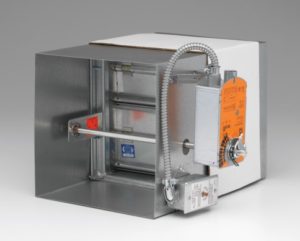Thousands of fire dampers are situated within the fire walls of office buildings, care homes, hotels and apartment blocks. But like all such systems – fitted incorrectly, moved during a retrofit, or simply not properly maintained, they can fail to prevent fire spreading quickly throughout the building.
Fire Damper Installation, Testing and Maintenance

A fire damper plays a crucial role in a building’s fire safety system. If they do not operate as designed, fire can spread with rapid, lethal results. Fire dampers prevent the spread of fire through heating, ventilation or air conditioning ducts. They are part of the passive fire protection system and fire strategy of a building; closing the shutter blade of the damper to prevent the spread of fire within the ducts. With the enactment of the Regulatory Reform (Fire Safety) Order 2005, it is now the employer’s responsibility to maintain their fire safety systems.
In the most common design, a fusible link holds a spring-loaded shutter blade open. However, there are also many other designs employed. When the temperature exceeds the limit (typically 72° C) the link ‘fuses’, or melts; the shutter blades are sprung, closing off the open air stream to prevent the spread of fire through the ducting. Fire dampers are open most, if not all, of the time, so it is crucial to make sure they are fully functioning such that they will shut effectively when required. Effective fire dampers work by providing a barrier beyond which the fire cannot pass.
Regular fire damper testing, cleaning and maintenance is essential as a legal requirement and as a critical part of building fire safety management. In the case of a fire, the difference between a well-maintained, working fire damper and an ill-maintained, partially working fire damper can be the difference between life and death. Regular fire damper testing (known as drop-testing), cleaning and maintenance is essential – both as a legal requirement and as a critical part of building fire safety management.
Our team of Certified Fire Technicians and City & Guilds NVQ Certified Engineers, can inspect any motorised or fusible-linked fire damper system currently installed within your building; carrying out a service, drop-testing and carrying out repairs, if necessary.
Reporting
At the conclusion of a fire damper test, Chute Fire Certification UK® provides the client with a detailed report that includes:
- Live on-site photographic and written report evidence that a comprehensive fire damper test has been performed.
- An inventory of all dampers tested, including location and damper number, inspection results and, if the damper failed to operate, detailed explanation and suggested corrective action taken and/or required
Fire Damper Installation & Refurbishments
Our in-house expertise puts us at the forefront of innovation in the commercial installation industry. Our team of highly qualified and Certified City & Guilds NVQ level Ductwork Engineers, and fire and smoke damper installation specialists can handle all refurbishment requirements – from initial concept & design/planning, sourcing, installation and maintenance, project management, bespoke design manufacturing and installation, services and any other areas within major redesign.
According to BS 9999:2017 – Code of Practice for the Fire Safety in the Design, Management and Use of Buildings: Maintenance of air conditioning and ventilation equipment including air filters, motors, fire dampers and their controls, smoke detectors and alarms is of paramount importance both in preventing fire and in ensuring that measures taken to mitigate its consequences are effective when needed.
Arrangements should be made for all fire plates and dampers to be tested by a competent person on completion of the installation and at regular intervals not exceeding 12 months. They are to be repaired or replaced immediately if found to be faulty. Spring operated fire dampers should be tested annually and fire dampers in dust laden and similar atmospheres should be tested much more frequently, at periods suited to the degree of pollution.
Related Services

REFUSE CHUTE SERVICE & FIRE INSPECTION
We test and inspect all aspects of the chute to British Standards, including smoke seals, hopper doors, exit section and fire plates/dampers; in addition to checking the bin room is safe from arson. Upon successful completion, the refuse chute will be certified Fire Safe according to the latest fire legislation.

FIRE RISK ASSESSMENTS
Annual fire risk assessments are an organised and systematic examination of your premises and business, in order to understand the likelihood that a fire could start and cause harm to people. Our comprehensive report using the latest PAS 79 methodology and other fire-related documentation meets National Standards to ensure your business compliance.